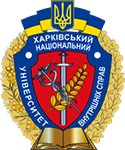Legal and Organizational Principles of Militia Activities of the Ukrainian Soviet Socialist Republic in 1956
DOI:
https://doi.org/10.32631/v.2021.3.01Keywords:
Ukraine, 1956, Ministry of Internal Affairs, militia, counteraction to crime.Abstract
The year 1956 was significant both in the history of Ukraine and the USSR, but also for world history. The death of I.V. Stalin in 1953 marked the beginning of the partial liberalization of the political regime in the Soviet Union; the strongest impetus for the continuation and intensification of this process was in 1956, the year of the XX Congress of the CPSU and the CPSU Central Committee Resolution “On overcoming the Stalin’s cult of personality and its consequences”, where a lot of terrible truth about the Soviet past was told for the first time. This significantly changed the political and socio-economic situation in the country, in fact prevented further mass repression of the population and significantly changed the role of law enforcement agencies, which really began to acquire the characteristics of law enforcement. There was a change of the heads of the Ministry of Internal Affairs of the USSR and the Ukrainian SSR, which was another step in clearing the state leadership of the most odious Stalinist personnel and meant strengthening the control of the communist party agencies over the militia. The new leadership of the Ministry of Internal Affairs believed that the main shortcoming in the activities of the militia was the lack of activity in the fight against crime and the significant level of crime among police officers themselves. There were also shortcomings in the operative work on crime prevention and detection. The selection and placement of personnel was badly organized in the Ministry of Internal Affairs. There were many cases, when people without proper training were assigned to important areas of operative and investigative work in the militia. Departments of the Ministry of Internal Affairs and militia divisions in oblasts were reorganized into unified departments of internal affairs of executive committees of oblast Soviets of Workers’ Deputies, and militia departments in cities and districts were transformed into militia divisions of executive committees of city and district councils. That meant the resumption of dual subordination of local law enforcement agencies to executive committees of councils and the Ministry of Internal Affairs. But that reorganization did not have the desired effect.
Downloads
References
Skilyagin A.T., 1976. Soviet militia during the construction of developed socialism: 1945-1958 [Sovetskaya militsiya v period stroitel’stva razvitogo sotsializma: 1945-1958 gg.]. Leningrad: VPU MVS USSR.
Kovaleva E.M., 2002. Organizational and legal foundations of the activities of the Soviet militia in the fight against crime in the post-war period of restoration of the national economy and liberalization of the political regime, socio-economic reforms (1945-1960) [Organizatsionno-pravovye osnovy deyatel’nosti Sovetskoi militsii po bor’be s prestupnost’yu v poslevoennyi period vosstanovleniya narodnogo khozyaistva i liberalizatsii politicheskogo rezhima, sotsial’no-ekonomicheskikh reform (1945-1960 gg.)]. Ph.D. dissertation. Moscow Academy of the Ministry of Internal Affairs of Russia.
Lur`e L. and Malyarova I., 2007. 1956. Mid-century [1956 god. Seredina veka]. St. Petersburg: Neva.
Strokach Tymofiy Amvrosiyovych (1903-1963). Lieutenant-General [Strokach Tymofii Amvrosiiovych (1903-1963). Heneral-leitenant], 2016. In: Verbenskyi M.H., Yarmysh O.N., Kryvolapchuk V.O. et al. Ministry of Internal Affairs of Ukraine: events, leaders, documents and materials (1917–2017) [Ministerstvo vnutrishnikh sprav Ukrainy: podii, kerivnyky, dokumenty ta materialy (1917-2017 rr.)]: in 6 vols. Vol. 6. Kyiv: Machulin. (Ed.: Avakov A.B.). P. 38.
Gulyakov A.D., Kolemasov V.N., Lobanov A.V. et al., 2016. History of the internal affairs bodies of Russia [Istoriya organov vnutrennikh del Rossii]. Penza: Izdatel`stvo PGU.
Petrov N.V., 2010. Who led the state security agencies: 1941-1954 [Kto rukovodil organami gosbezopasnosti: 1941-1954]. Moscow: Memorial; Zven’ya.
Ministry of Internal Affairs of the USSR during the period of de-Stalinization (March 5, 1953 - 5 September 1962) [Ministerstvo vnutrishnikh sprav URSR u period destalinizatsii (5 bereznia 1953 - 5 veresnia 1962 r.], 2016. In: Verbenskyi M.H., Yarmysh O.N., Kryvolapchuk V.O. et al. Ministry of Internal Affairs of Ukraine: events, leaders, documents and materials (1917–2017) [Ministerstvo vnutrishnikh sprav Ukrainy: podii, kerivnyky, dokumenty ta materialy (1917-2017 rr.)]: in 6 vols. Vol. 6. Kyiv: Machulin. (Ed.: Avakov A.B.). P. 26.
Gontovoi R., 1956. In defense of the rights of citizens [V zashchitu prav grazhdan]. Pravda Ukrainy. 13 July.
Ganzhurov Yu.S., 1999. Black and white "thaw" in the mirror of the press: newspaper publications as a source of study of the political system of Ukraine (1956-1964) [Chorno-bila «vidlyha» u dzerkali presy: hazetni publikatsii yak dzherelo vyvchennia politychnoi systemy Ukrainy (1956-1964 rr.)]. Kyiv: Oriiany.



